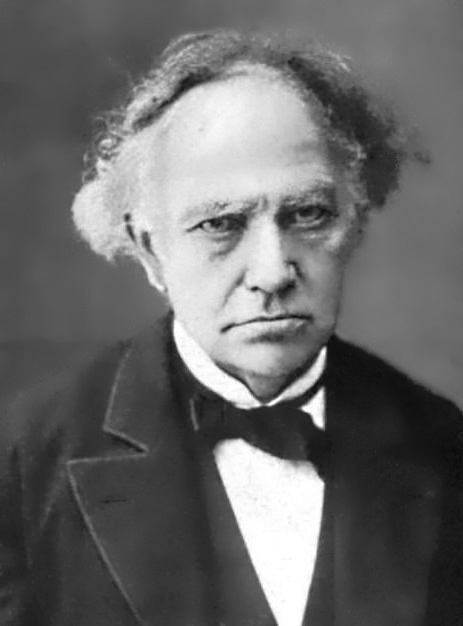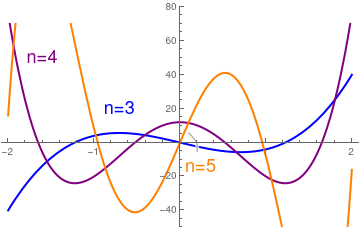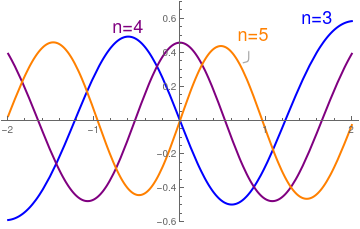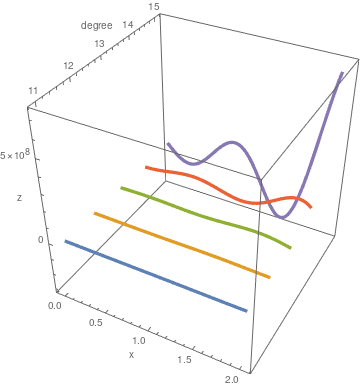Return to computing page for the first course APMA0330
Return to computing page for the second course APMA0340
Return to computing page for the fourth course APMA0360
Return to Mathematica tutorial for the first course APMA0330
Return to Mathematica tutorial for the second course APMA0340
Return to Mathematica tutorial for the fourth course APMA0360
Return to the main page for the first course APMA0330
Return to the main page for the second course APMA0340
Return to the main page for the fourth course APMA0360
Return to Part V of the course APMA0340
Introduction to Linear Algebra with Mathematica
Glossary
Preface

The Hermite polynomials, conventionally denoted by Hn(x), were introduced in 1859 by Pafnuty Chebyshev. Later, in 1864 they were studied by the French mathematician Charles Hermite (1822--1901).
Hermite polynomials can be defined "explicitly" as
Numerical evaluation of Hermite's polynomials is an ill-posed problem. The main challenge is an alternating series \eqref{EqHermite.1} with growing coefficients. Mathematica has build in command for these polynomials: HermiteH[n, x].
Note that the leading coefficient in the Hermite polynomial Hn(x) = 2nxn + ··· grows exponentially. It is convenient to consider similar polynomials but with leading coefficient to be 1. The corresponding polynomials are denoted by Hen(x). The sequence { Hen(x)} of classical orthogonal polynomial, called Chebyshev--Hermite polynomials, are defined by the following formula:
We can define the Chebyshev--Hermite polynomials with the following Mathematica command:
One can define the (normalized) Hermite functions:
Another orthonormal basis in the Hilbert space 𝔏²(− ∞, ∞) constitute the functions named after Chebyshev--Hermite:
Hermite Polynomials
The Hermite polynomials \( H_n (x) \) can be also defined by the exponential generating function
Expand[SeriesCoefficient[g[t], {t,0,n}]*n!]
HermiteH[n, x]
| n | Hermite polynomial | Chebyshev--Hermite polynomial | ||
|---|---|---|---|---|
| n = 0 | H0(x) = 1 | He0(x) = 1 | ||
| n = 1 | H1(x) = 2x | He1(x) = x | ||
| n = 2 | H2(x) = 4x² −2 | He2(x) = x² −1 | ||
| n = 3 | H3(x) = 8x³ −12x | He3(x) = x³ −3x | ||
| n = 4 | H4(x) = 16x4 −48x² + 12 | He4(x) = x4 −6x² + 3 | ||
| n = 5 | H5(x) = 32x5 −160x³ + 120x | He5(x) = x5 −10x³ + 15x | ||
| n = 6 | H6(x) = 26x6 −480x4 −720x² − 120 | He6(x) = x6 −15x4 + 45x² −15 | ||
| n = 7 | H7(x) = 27x7 −1344x5 + 3360x³ −1680x | He7(x) = x7 −11x5 + 105x³ − 105x | ||
| n = 8 | H8(x) = 28x8 −3584x6 + 13440x4 −13440x² + 1680 | He8(x) = x8 −28x6 + 210x4 −420x² + 420 | ||
| n = 9 | H9(x) = 29x9 −9216x7 + 48384x5 −80640x³ + 30240x | He9(x) = x9 −36x7 + 378x5 −1260x³ + 945x |
Example 1: The Chebyshev--Hermite differential equation
For arbitrary λ, the Hermite equation (1.1) can be solved using the series method
These are the recurrence relations or finite difference. Sometimes (but not always!) it is the case that the recurrence relations can be written for n = 0, 1, 2, 3, ….. We see here that n = 0 in the second equation gives us 2𝑎2 − λ𝑎0 = 0, so the first equation is really the second with n = 0. A bit of algebra gives us for the recurrence relations:
What follows is particularly of interest to physicists, since the Chebyshev--Hermite polynomials Hen(x) arise in solving the Schrödinger equation for a harmonic oscillator. However, it also shows one way in which special functions arise from differential equations, so in that sense it is of interest to all.
If λ is nonnegative even integer, then λ = 2m, and something interesting happens to our solutions. One of these solutions will become a polynomial in this case–the first if m is even, and the second if m is odd. Let’s see how this happens.
Assume m is even, then
Similar calculations can be made when m is odd. The product in the numerator will have a zero factor when 2k + 1 − m = 0. Therefore, we stopped the summing at k = (m − 1)/2. This is an integer since m is odd.
The Chebyshev--Hermite polynomial Hem(x) is defined as the polynomial solution to the Chebyshev--Hermite equation (1.1) with λ = 2m for which the coefficient of xm is 1. The Chebyshev--Hermite polynomials are found from flipping back and forth between y ₁ and y ₂, depending on which one has the terminating infinite sum, and then normalizing.
The Hermite polynomials form a complete orthogonal system in the Hilbert space 𝔏²(ℝ, e−x²) with respect to the following inner product: \[ \langle f\,\vert\,g \rangle = \langle f,g \rangle = \int_{-\infty}^{\infty} f(x)\,g(x)e^{−x^2} \,{\text d}x \qquad \mbox{where} \qquad \| f \| = +\sqrt{\langle f,f \rangle} \] is called the norm in this Hilbert space. Note that integration in the inner product is understood in Lebesque sense rather than Riemann to make the space 𝔏²(ℝ, e−x²) complete. Note that there are two notations for inner product, either the bra-ket notation (in physics following P. Dirac) with vertical line separating functions or comma (in mathematics). The orthogonality condition for Hermite polynomials is read as
Both polynomials, Hn(x) and Hen(x), are nth-degree polynomials for n = 0, 1, 2, … and the symmetry relation holds
The roots of the n-th Hermite or Chebyshev--Hermite polynomial are important because they are the quadrature points for the Hermite–Gauss numerical integration scheme:
They also are the collocation points for Hermite function pseudospectral schemes for solving differential equations. The equation Hn(x) = 0 has n real zeroes on the interval spanned by the turning points, \( \displaystyle x \in [-\sqrt{2n+1}, \sqrt{2n+1}] . \)
Hermite Functions
Since the leading coefficient (2n) of the Hermite polynomial Hn(x) grows exponentially and it is a sum of alternating terms, its numerical evaluation becomes ill-posed. Therefore, for computational point of view Hermite functions are more preferable to use.
One can define the Hermite functions of degree n (wave functions) as follows:
| n | Hermite functions | |
|---|---|---|
| n = 0 | \( \displaystyle \psi_0 (x) = \pi^{-1/4} e^{-x^2 /2} \) | |
| n = 1 | \( \displaystyle \psi_1 (x) = \frac{x\,\sqrt{2}}{\pi^{1/4}}\, e^{-x^2 /2} \) | |
| n = 2 | \( \displaystyle \psi_2 (x) = \left[ x^2 \sqrt{2} - \frac{1}{\sqrt{2}} \right] \pi^{-1/4}\, e^{-x^2 /2} \) | |
| n = 3 | \( \displaystyle \psi_3 (x) = x \left[ x^2 \sqrt{4/3} - \sqrt{3} \right] \pi^{-1/4}\, e^{-x^2 /2} \) | |
| n = 4 | \( \displaystyle \psi_4 (x) = \left[ x^4 \sqrt{2/3} - x^2 \sqrt{6} + \frac{\sqrt{6}}{4} \right] \pi^{-1/4}\, e^{-x^2 /2} \) | |
| n = 5 | \( \displaystyle \psi_5 (x) = x \left[ x^4 \frac{2}{\sqrt{15}} - x^2 \frac{10}{\sqrt{15}} + \frac{\sqrt{15}}{2} \right] \pi^{-1/4}\, e^{-x^2 /2} \) | |
| n = 6 | \( \displaystyle \psi_6 (x) = \left[ x^6 \frac{2}{3\sqrt{5}} - x^4 \sqrt{5} + x^2 \frac{3\sqrt{5}}{2} - \frac{\sqrt{5}}{4} \right] \pi^{-1/4}\, e^{-x^2 /2} \) | |
| n = 7 | \( \displaystyle \psi_7 (x) = x \left[ x^6 \frac{4}{3\sqrt{70}} - x^4 \frac{14}{\sqrt{70}} - x^2 \frac{\sqrt{35}}{\sqrt{2}} + \frac{\sqrt{35}}{2\sqrt{2}} \right] \pi^{-1/4}\, e^{-x^2 /2} \) | |
| n = 8 | \( \displaystyle \psi_8 (x) = \frac{1}{24\sqrt{70}} \left[ 16\,x^8 - 224\,x^6 + 840\, x^4 - 840\, x^2 + 105 \right] \pi^{-1/4}\, e^{-x^2 /2} \) | |
| n = 9 | \( \displaystyle \psi_9 (x) = \frac{x}{72\sqrt{35}} \left[ 16\,x^8 - 288\, x^6 + 1512\, x^4 - 2520\, x^2 + 948 \right] \pi^{-1/4}\, e^{-x^2 /2} \) |
| n | Chebyshev--Hermite functions | |
|---|---|---|
| n = 0 | \( \displaystyle h_0 (x) = \left( 2\pi \right)^{-1/4} e^{-x^2 /4} \) | |
| n = 1 | \( \displaystyle h_1 (x) = x \left( 2\pi \right)^{1/4}\, e^{-x^2 /4} \) | |
| n = 2 | \( \displaystyle h_2 (x) = \frac{x^2 -1}{\sqrt{2}} \left( 2 \pi \right)^{-1/4}\, e^{-x^2 /4} \) | |
| n = 3 | \( \displaystyle h_3 (x) = x\, \frac{x^2 -3}{\sqrt{6}} \left( 2\pi \right)^{-1/4}\, e^{-x^2 /4} \) | |
| n = 4 | \( \displaystyle h_4 (x) = \frac{x^4 -6x^2 +3}{2\sqrt{6}} \left( 2\pi \right)^{-1/4}\, e^{-x^2 /4} \) | |
| n = 5 | \( \displaystyle h_5 (x) = x \, \frac{x^4 -10 x^2 + 15}{2\sqrt{30}} \left( 2\pi \right)^{-1/4}\, e^{-x^2 /4} \) | |
| n = 6 | \( \displaystyle h_6 (x) = \frac{x^6 -15 x^4 + 45 x^2 -15}{12\sqrt{5}} \left( 2\pi \right)^{-1/4}\, e^{-x^2 /4} \) | |
| n = 7 | \( \displaystyle h_7 (x) = x \, \frac{x^6 -21 x^4 + 105 x^2 -105}{12\sqrt{35}} \left( 2 \pi \right)^{-1/4}\, e^{-x^2 /4} \) | |
| n = 8 | \( \displaystyle h_8 (x) = \frac{x^6 -21 x^4 + 105 x^2 -105}{24\sqrt{70}} \left( 2 \pi \right)^{-1/4}\, e^{-x^2 /4} \) | |
| n = 9 | \( \displaystyle h_9 (x) = x\,\frac{x^8 - 36 x^6 + 378 x^4 -36 x^2 + 945}{72\sqrt{70}} \left( 2 \pi \right)^{-1/4}\, e^{-x^2 /4} \) |
Example 2: We plot some Hermite polynomials and functions.
Plot[{psi[3, x], psi[4, x], Callout[psi[5, x], Style["n=5", 18, Orange], {0.8, .35}]}, {x, -2, 2}, PlotRange -> {-0.6, 0.6}, PlotStyle -> {{Blue, Thick}, {Purple, Thick}, {Orange, Thick}}, Epilog -> {{Text[Style["n=3", 18, Blue], {1.6, 0.6}]}, {Text[ Style["n=4", 18, Purple], {-0.6, 0.55}]}}]

|

|
|
| Hermite polynomials for n = 3, 4, 5. | Hermite functions for n = 3, 4, 5. |

|
We can also plot Hermite's polynomials side by side:
f[n_, x_] := HermiteH[n, x];
Table[Plot[f[n, x], {x, 0, 1}], {n, 5, 15}] ParametricPlot3D[ Evaluate@Table[{x, n, f[n, x]}, {n, 11, 15}], {x, 0, 2}, AxesLabel -> {"x", "degree", "z"}, BoxRatios -> 1, PlotRange -> Full, PlotStyle -> Thickness[0.01]] |
As it is seen from the previous example, the Hermite polynomials and functions change from oscillatory behavior to monotonic, exponentially decay at the “turning points." In the vicinity of the turning points, the Hermite functions are approximated in terms of the Airy function, Ai(z),
Fourier transforms
Fourier transform of the Hermite functions are given in the following
We check with Mathematica for n = 6,7,8.
We check with Mathematica for n = 5, 6.
Simplify[Integrate[Exp[I*x*t/2]*h[5, x], {x, -Infinity, Infinity}]/ h[5, t]]
Example 3: Let Y = N(μ, σ) be a general Gaussian distribution with mean μ and standard deviation σ. In order to compute the moments of the random variable Y, we rewrite the integral representation of Chebyshev-Hermite polynomial as follows,
Rodrigues formulae and Error Function
Many applications utilize a special function known as the error function:
The French banker, mathematician, and social reformer Odile Rodrigues showed in 1816 that a large class of second-order Sturm-Liouville ordinary differential equations (ODEs) had polynomial solutions that could be put in a compact and useful form now generally called Rodrigues formulae.
Hermite polynomials can be defined also via Rodrigues formula:
The Rodrigues formula shows that Hermite polynomials are closely related to the error function
For Hermite functions, we have
Since
Recurrences
Recurrence relations for Hermite polynomials:
Hermite functions can be efficiently computed using a three-term recursion relation from two starting values:
Simplify[psi[9, x] - Sqrt[2/9]*x*psi[8, x] + Sqrt[8/9]*psi[7, x]]
Similarly,
Simplify[x*h[8, x] - 3*h[9, x] - Sqrt[8]*h[7, x]]
Derivatives are expressed via Appell's formula:
Example 4: We claim that the convolution of a standard Gaussian distribution with the nth Chebyshev-Hermite polynomial is
For Hermite functions, we have
Simplify[2*D[h[8, x], x] + 3*h[9, x] - Sqrt[8]*h[7, x]]
Simplify[D[Exp[-x^2/2]*ch[5, x], x]*Exp[x^2/2]/ch[6, x]]
Ladder operators
In quantum mechanics, a ladder operator is an operator that increases or decreases the eigenvalue of another operator. Correspondingly, there are two of the ladder operators, known as a raising or creation operator and lowering or annihilation operator. Since we have two orthonomal bases (Hermite functions and Chebyshev--Hermite functions) in Hilbert space 𝔏²(ℝ), we need two kinds of ladder operators. For Hermite functions, we denote them with letter using bold fonts as it is common in mathematics. On the other hand, we utilize letters with hat as they are usually written in physics.
So we define the creation operator as
Similarly, we have
Upon introducing the Hermite differential operator
This yields
Example 5:
We introduce a lowering (or annihilation) operator \( \hat{a} \) and a raising, or creation, operator \( \hat{a}^{\ast} \) according to the formulas:
Using commutation relations
We introduce a lowering (or annihilation) operator \( \hat{a} \) and a raising, or creation, operator \( \hat{a}^{\ast} \) according to the formulas:
Simplify[-D[h[8, x], x, x] + (x^2/4)*h[8, x] - (2*8 + 1)/2*h[8, x]]
Example 6: The harmonic oscillator is almost ubiquitous model system in any field of physics. Here we present a fairly solid and pedagogically effective way to treat the quantum harmonic oscillator. It is one of the few problems that can really be solved in closed form, and is a very generally useful solution, both in approximations and in exact solutions of various problems.
As t was discussed in tutirial I (see section viii), a harmonic oscillator is a model that describes a particle of mass m moving in a single direction and subject to a restoring force that is proportional to the displacement of the particle (also is known as Hooke's law). In classical Newtonian mechanics this means that the acting force is proportional to the displacement x:
In quantum mechanics, the harmonic motion begins with the specification of the Schrödinger equation
Substituting the definitions for the operators yields
This Hamiltonian appears in various applications, and in fact the approximation of the harmonic oscillator is valid near the minimum of any potential function. Application of separation of variables to the Schrödinger equation, Ψ = T(t) w(x), we obtain
Example 7: We consider Sturm--Liouville problem for harmonic oscillator (6.4) from the previous example in case when κ = 1:
Example 8: We consider Sturm--Liouville problem for harmonic oscillator (6.4) from the previous example in case when κ = ½:
Sturm--Liouville problems
The Chebyshev--Hermite polynomials Hen(x) are eigenfunctions corresponding to eigenvalues λ = n of the Sturm--Liouville problem for the Hermite differential equation on the infinite interval \( (-\infty , \infty ) : \)
The Hermite functions are the eigenfunctions of the elliptic operator \( - \frac{{\text d}^2}{{\text d} x^2} + x^2 . \) These functions are solutions to the differential equation that involves a quantum mechanical, simple harmonic oscillator:
Useful Formulas
Hermite polynomials admits a symmetry relation:
The Hermite polynomials evaluated at zero argument are called Hermite numbers.
- Hermite Functions, Springer.
- Kagawa, T.: Hermite function expansions of Heaviside function. Journal of Pseudo-Differential Operators and Applications, 2015, 6, No. 1, pp. 21–32.
- Kagawa, T. & Yoshino, K., The Hermite expansion of the characteristic functions, Journal of Pseudo-Differential Operators and Applications, 2017, Vol. 8, No. 2, pp. 255–273. https://doi.org/10.1007/s11868-017-0188-x
- Sadlok, Z. On Hermite expansion of x^p, Annales Polonici mathematici, 1980, 38, pp. 159--162. doi: 10.4064/ap-38-2-159-162
- Thangavelu, S., Lectures on Hermite and Laguerre Expansions Mathematical Notes, 42. Princeton University Press, Princeton, New Jersey, 1993.
Return to Mathematica page
Return to the main page (APMA0340)
Return to the Part 1 Matrix Algebra
Return to the Part 2 Linear Systems of Ordinary Differential Equations
Return to the Part 3 Non-linear Systems of Ordinary Differential Equations
Return to the Part 4 Numerical Methods
Return to the Part 5 Fourier Series
Return to the Part 6 Partial Differential Equations
Return to the Part 7 Special Functions